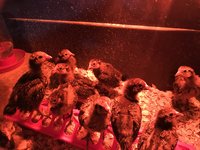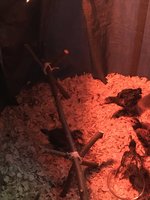Chickening101
Chirping
Hello, everyone! This is going to be an educational thread on caring for chicks.
Feel free to ask questions about caring for chicks.
Enjoy!
The first 2 days
For the first 2 days of a chicks life, they don't need to be fed, because they'll live on the yolk that's still inside them. but you should give them heat.Feel free to ask questions about caring for chicks.
Enjoy!
The first 2 days
On the 3rd day, give them immediate food and water.
Bedding--the good and the bad
-Pine Shavings: they're a good choice, but just make sure the chicks don't eat them. You can stop them from eating them by putting soft dish towels or rags on top of a 1 or 2 inch layer of them, and then remove the towels when they are at least a month old, for they will be less likely to eat them then, rather then newborn chicks.-Newspaper: don't use newspaper, it can create splayed leg, a common leg disability in chicks.
-Straw: it's okay, but doesn't absorb that well, so it will need to be changed regularly.
-Hay: don't use hay, as it gets damp and can cause fungal spores that can cause aspergillosis.
-Shredded Paper: don't use, it's clots together and isn't absorbent
Heat
Make sure your chicks have a constant heat source.Go down five degrees each week, starting at 95 degrees farhenheit.
Feed
Feed your chicks starter feed.Each brand of starter feed has a different time to move on to grower feed.
It's your choice if you want to give your chicks medicated, non-medicated, or organic feed.
Those are the basics. Ask questions and I'll do my best to answer them!
Hope this helps!
Hope this helps!

 ).
).






